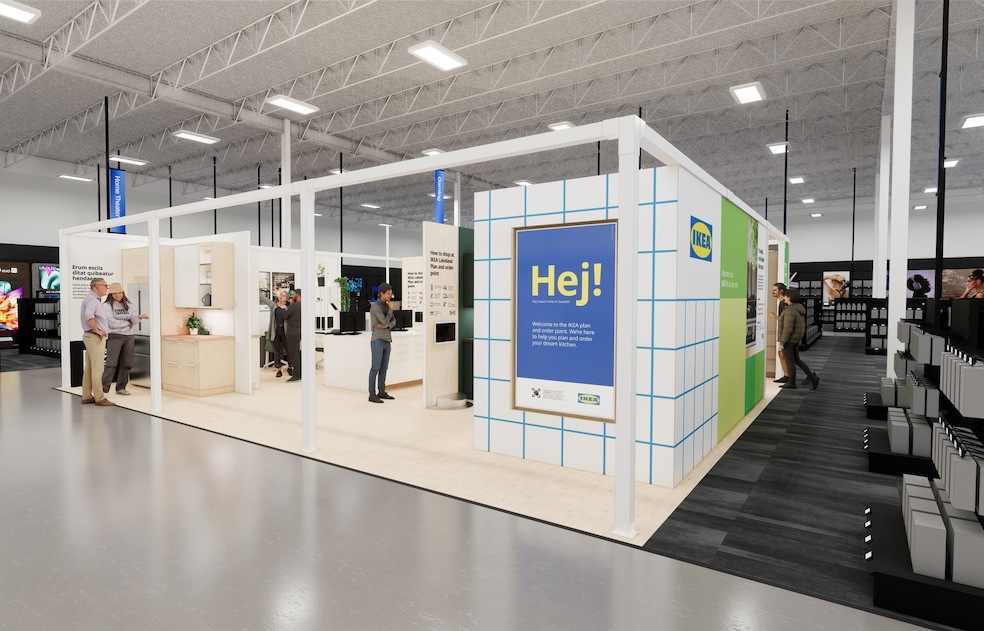Although known for its mammoth, labyrinthine storefronts, the U.S. arm of Swedish furniture giant Ikea is sizing down for a new partnership with appliance retailer Best Buy.
Best Buy and Ikea announced the “shop-in-shop” crossover in a press release Thursday, explaining that the pilot will manifest as miniature Ikea storefronts — think 1,000-square-foot expo booth — nestled within a given Best Buy store. Inside these Ikea footprints, shoppers can peruse kitchen, storage and laundry room layouts that combine appliances from Best Buy with designs and furnishings from Ikea.
The partnership, Best Buy and Ikea noted, also marks the “first time IKEA products and services will be accessible through another U.S. retailer, creating innovative ways for both retailers to meet customer needs in a rapidly changing environment.”
The retailers will plant the “new in-store collaboration,” slated to launch in the fall, inside 10 Best Buy stores in Florida and Texas, the press release stated. Staffed by Ikea and Best Buy employees alike, the shop-in-shops aim to offer a “one-stop destination” that makes “great design and functionality more accessible for the many,” Rob Olson, chief operation officer of Ikea U.S., said in the same release.
Nationwide construction unemployment rate under 10% in June
All 50 states had a construction unemployment rate below 10%, according to an analysis from the Associated Builders and Contractors trade group.
The Washington, D.C.-based organization found that the not-seasonally adjusted construction employment rate for June was 3.4%, up one-tenth of a percent from the same month last year. At the same time, however, National NSA payroll construction employment rose by 114,000 compared to June 2024, putting seasonally adjusted payroll construction at 8.3 million, still above the prepandemic height of 7.6 million.
“While June state construction unemployment rates continue to indicate a relatively healthy level of construction employment, uneasiness that the economy might weaken over the remainder of this year and into 2026 is producing some hesitancy among builders and developers about proceeding with new projects,” said Bernard Markstein, president and chief economist of Markstein Advisors, who conducted the analysis for ABC.
Overall, 18 states had lower estimated rates, 28 had higher unemployment rates, and four states had flat rates. South Dakota, North Dakota, New Hampshire, Montana and Oklahoma had the lowest estimated NSA construction unemployment rates, while Rhode Island, New Jersey, Connecticut, New Mexico and Maryland were the five states with the highest.
Extreme weather, tariffs cited as home insurance costs rise
As homeowners face increasing uncertainty — climate-driven and economic — the average home insurance premiums for new policies are on the rise and making homeownership less attainable, Matic, a Columbus, Ohio-based insurance provider, says.
Since 2024, premiums rose 9.3% over the first half of 2025, according to company data. They averaged $1,966, continuing a trend of rising costs, albeit at a slower pace than in recent years.
"In some cases, homeowners are now spending more than half of their monthly mortgage payment on insurance and taxes,” Ben Madick, Matic’s CEO and cofounder, said in an announcement from the company. “An increasing number of people are finding that rising insurance costs are standing in the way of buying a home or making it harder to keep the one they have."
With premiums rising by 45% since 2022, Matic’s report points toward “climate volatility” bearing a large portion of the blame, with disasters including hurricanes, tornadoes and flooding accounting for “70% of global insured losses in recent years" and driving double-digit premium increases in states like Colorado, Mississippi and Texas, Matic reported.
Federal tariffs are “another driver of rising insurance costs,” according to the report. With “tariffs on copper, steel and aluminum now in place or expected soon, builders are bracing for increased material prices that could raise replacement costs and, in turn, premiums.”

